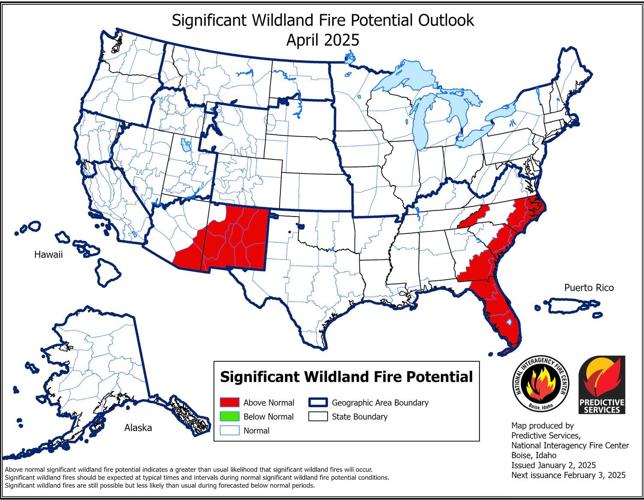It's barely February, but Taos County Forest and Watershed Health Program Manager J.R. Logan warned officials this week there will be above-normal wildland fire potential as early as April this year.
"Unless things change significantly, the smartest people in the country who predict wildfire seasons expect basically all of the state of New Mexico to be in significant wildfire potential by April," Logan said during a presentation to the Taos County Commission Tuesday (Jan. 28). "That's about a couple months ahead of schedule, and God knows what they're going to find come May or June if things don't change."
Logan said the energy release component, or the available energy per unit area in a wildfire prone region, is already on the high end, adding "normally we're at about 10-20 percent" at the end of January but are currently in the "50th percentile."
"This is essentially saying how dry is the fuel out in the forest right now," he said. "This is the kind of numbers that we see far later in the season, and this is obviously because of how dry its been this winter."
Because of the dire outlook, forest and wildland fire officials are already in overdrive completing fire risk mitigation strategies before it becomes too dry and windy in the spring to conduct, for example, pile burns or broadcast burns, or even to use chainsaws and other tools that cast sparks.
"Come April or May, it's very likely not going to be safe to work in the woods," Logan said. "The work that we're trying to accomplish is in preparation for seasons like this. But there's only so much we can do and so this is going to be a buckle-up kind of fire season."
There are many preparations and risk reduction strategies homeowners and individuals can undertake to anticipate "what's likely to be a pretty bad wild fire season," Logan said, directing people to the New Mexico State Forestry Division for tips on creating defensible space around homes and structures, particularly in the wildland-urban interface where so many Northern New Mexicans live.
As many New Mexicans witnessed in footage from Los Angeles this month, wildfire can spread extremely quickly, so it's important to have an evacuation plan in place, including a go bag and a predetermined place to meet friends and loved ones.
The New Mexico "Ready, Set, Go" manual for fire preparedness is available online at emnrd.nm.gov/sfd/fire-prevention-programs/ and at most U.S. Forest Service and U.S. Bureau of Land Management offices. The manual states: "It’s not a question of if, but when, the next major wildfire will occur in New Mexico."
Taos County forestry businesses, the Carson National Forest, fire departments and individuals across the Enchanted Circle have ramped up efforts in recent years to reduce the risk of catastrophic wildfire here. It all comes down to promoting watershed health, Logan said, directing people to the 2022 Taos County Community Wildfire Protection Plan available at taoscountywildfire.org.
"Fire is not new to Northern New Mexico, in fact it's a necessary process in our forests," Logan said. "It's part of what kept the forests healthy for eons."
A surge in state and federal funds for tree thinning projects and prescribed pile burns and broadcast burns, as well as planning and data collection has enabled the region to perform a lot of work since a federal pause on burns was lifted after the Calf Canyon–Hermits Peak Wildfire burned across over 341,000 acres in Mora, San Miguel, Taos and Colfax counties. There is still a lot of work to do, however, in the Enchanted Circle's overgrown forests.
Pile burns to remove deadfall and understory along NM 150 in Taos Ski Valley, for example, are ongoing, with a focus beginning as early as Thursday (Jan. 30) along the Wheeler Peak Trail. This week the Carson National Forest also announced pile burns will likely be ignited in the coming days south of Peñasco, as well as in and around Arroyo Hondo, San Cristobal and Turley Mill.
Not only does watershed restoration reduce the risk of catastrophic wildfire, promote wildlife habitat and water quality, it also protects homes, which Logan noted "is the county's tax base."
Local forestry businesses provide jobs. Forest mayordomo programs reconnect people with the land their ancestors cared for, providing added cultural benefits as well as forest products like latillas. Grace Powell, forest health and program manager for Taos Soil and Water Conservation district told the commission that her youth teams not only conduct forest management projects but find "opportunities for students to be empowered."
"We create land stewards," she said. Visit tswcd.org for more information.
















(1) comment
Please also include link for Taos residents to sign up for emergency notifications in stories like this.
https://www.taoscounty.org/371/Sign-Up-for-Taos-County-Mass-Notificatio
Welcome to the discussion.
Log In
All comment authors MUST use their real names. Posts that cannot be ascribed to a real person
will not be moderated.
Keep it Clean. Please avoid obscene, vulgar, lewd, racist or sexually-oriented language.
PLEASE TURN OFF YOUR CAPS LOCK.
Don't Threaten. Threats of harming another person will not be tolerated.
Be Truthful. Don't knowingly lie about anyone or anything.
Be Nice. No racism, sexism or any sort of -ism that is degrading to another person.
Be Proactive. Use the 'Report' link on each comment to let us know of abusive posts.
Share with Us. We'd love to hear eyewitness accounts, the history behind an article.